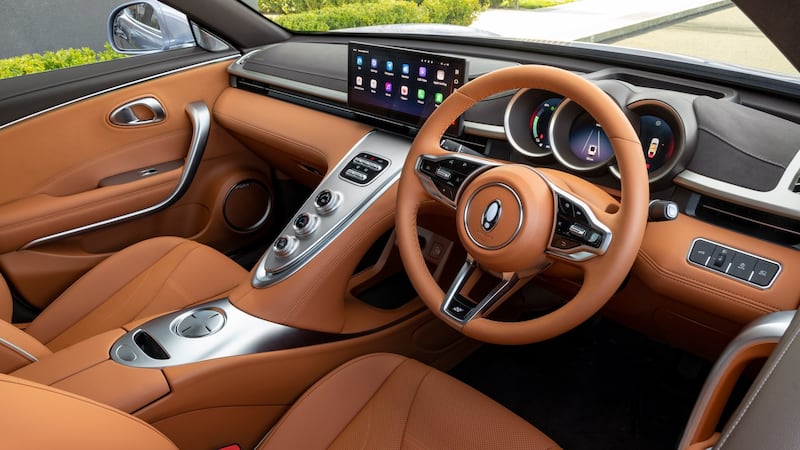The weather is appropriately aquatic – in that it’s raining so hard that it feels like standing at the bottom of a small harbour – as we get our first look, in Irish conditions (none more Irish, come to that) of Ora’s next electric car.
It’s called… well, we don’t actually know officially what it’s called yet. There is a name, and it’s definitely not the Lightning Cat name given to the car in its native China, which is a bit of a shame as not only does it establish a lineage with the cutesy-little Ora Funky Cat hatchback, but a slightly OTT name seems at least more fun than the likely number-based badge that the car will end up with.
Appropriately aquatic, though? Oh yes. While it might be called a cat in some markets, this new Ora saloon looks very fishy in its shape. Not in a bad way, but the way it’s curved and streamlined, with those anthropomorphic headlights, it looks very much like a Porsche Panamera crossed with some kind of futuristic space-squid-cyborg.
When it arrives in Ireland next summer, aside from having a name, it will also be needed an appropriate price tag. To compete with the likes of the updated Tesla Model 3 (which arrives in Ireland in January) and the BYD Seal (yet more fish references) it will need to cost in and around €40,000. Given that Ora’s Irish headquarters has just cut the base price of the Funky Cat to less than €30,000 (€29,995 if we’re being precise) it seems that a figure like that is very probable for the car.
READ MORE

European specs haven’t been finalised yet, but in China the car comes with an 82kWh battery, giving it a range of more than 600km, which is likely to be closer to 500km under European conditions. You’ll be able to choose between 204hp front-drive and 408hp four-wheel drive versions.
Inside, the thing that the new Ora resembles more than anything else is actually a Bugatti. No, seriously – there’s a lot of Veyron and Chiron in the way the centre console, with its round, metallic switches, rises from between the seats and sweeps up to meet the instrument panel. Those instruments are set into round, Alfa-Romeo-esque hoods, while the dashboard and door caps are covered in a delightfully soft suede-like material. The retention of those proper, physical buttons definitely gets the new Ora off to a good start in our book.
It definitely, and appropriately, feels like a step up from the Funky Cat cabin, and space in the back is fine – albeit no more than fine. One interesting touch is that the rear windscreen extends way into the roof, passing over the rear seat occupants’ heads before it meets any metal, which helps to put back the daylight stolen by the bulky, high-backed front seats.
Will Irish buyers take to a car that looks like a Porsche that lives in an aquarium? At the right price, they might but the Funky Cat has got off to a relatively poor sales start this year – just 30 registrations, compared with 447 of the BYD Atto 3 crossover, which is more expensive, just as new on the market, but far more conventional looking. Ora’s Irish team puts the relative failure down to a lack of promised, and much-needed, software updates arriving in time.

Equally, by the time the not-Lighting Cat goes on sale, the ground may have shifted under Ora’s feel. The European Union is circling the Chinese car makers, and already France has jumped the gun and announced that Chinese-made EVs won’t be eligible for some grants and rebates. What effect might that have on Ora’s position in the Irish market?
Responding to that question, a spokesperson for Great Wall Motors, the company that owns the Ora brand, told The Irish Times: “We have noted the EU Commission’s announcement with interest. As a commercial enterprise with a global value chain, we expect a balanced assessment of the overall situation and a refrain from unilateral protectionist regulatory measures by the EU. Great Wall Motor fully stands by its commitment and investment in Europe and wants to continue to contribute to the mobility revolution in Europe with high-quality products. We believe in free trade and are in favour of healthy competition. Instruments such as “punitive tariffs” should only ever be an extreme means of regulating a market event.
“Furthermore, we also refer to the statement of our industry association, the VDIK, which said: ‘Europe’s prosperity is largely based on the success of its export-oriented companies abroad. Free access to markets worldwide is therefore in the very best interest of the EU. Europe should therefore continue to stand up against protectionism and also erect as few barriers to access as possible for its own market. International companies should be able to trade in Europe free of discrimination.’”













